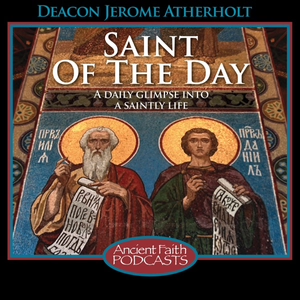
Saint of the Day
Jerome Atherholt and Ancient Faith Radio
All episodes
Best episodes
Top 10 Saint of the Day Episodes
Goodpods has curated a list of the 10 best Saint of the Day episodes, ranked by the number of listens and likes each episode have garnered from our listeners. If you are listening to Saint of the Day for the first time, there's no better place to start than with one of these standout episodes. If you are a fan of the show, vote for your favorite Saint of the Day episode by adding your comments to the episode page.

Our Holy Father Auxentius (470) - February 14th
Saint of the Day
02/14/24 • -1 min

Our Holy Godbearing Father Anthony the Great (356)
Saint of the Day
01/18/25 • -1 min

St John (Maximovich), Archbishop of Shanghai and San Francisco
Saint of the Day
07/02/21 • 4 min

St Leo, bishop of Catania in Sicily (~780)
Saint of the Day
02/20/21 • 2 min

12/30/20 • 2 min

12/29/20 • 2 min

Our Holy Mother Genevieve of Paris (~502)
Saint of the Day
01/03/21 • 3 min

07/01/22 • 1 min

07/03/22 • 1 min

St Theodore Trichinas (the Hair-shirt wearer), hermit near Constantinople (400) - April 20th
Saint of the Day
04/20/24 • -1 min
Show more best episodes

Show more best episodes
FAQ
How many episodes does Saint of the Day have?
Saint of the Day currently has 704 episodes available.
What topics does Saint of the Day cover?
The podcast is about Christianity, Spirituality, Russian, Religion & Spirituality, Saints, Podcasts, Holy, Orthodox, Daily, Church, Greek and Christian.
What is the most popular episode on Saint of the Day?
The episode title 'Our Holy Father Alexander, founder of the Monastery of the Unsleeping Ones (430)' is the most popular.
What is the average episode length on Saint of the Day?
The average episode length on Saint of the Day is 2 minutes.
How often are episodes of Saint of the Day released?
Episodes of Saint of the Day are typically released every day.
When was the first episode of Saint of the Day?
The first episode of Saint of the Day was released on May 7, 2019.
Show more FAQ

Show more FAQ